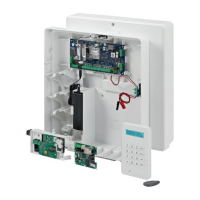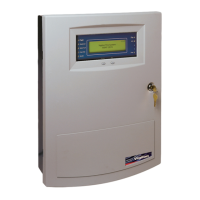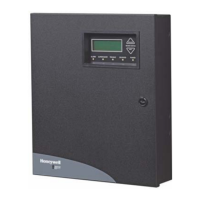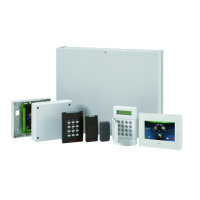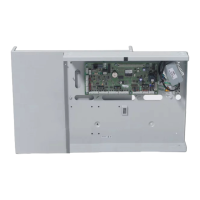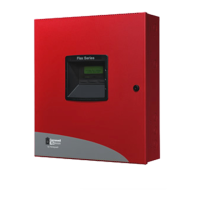
Do you have a question about the Honeywell GF505 and is the answer not in the manual?
| Brand | Honeywell |
|---|---|
| Model | GF505 |
| Category | Control Panel |
| Language | English |
How to provide comments and suggestions for improving the manual.
Lists reference documents from Gamewell-FCI for system components.
Lists key features and capabilities of the GF505 and GF510 Fire Alarm Control Panels.
Detailed technical specifications for AC power, batteries, and circuits.
Describes the LCD display, key panel, and LED indicators on the FACP.
Details the functions and connections of the integral DACT.
Lists the main components of the FACP, including circuit board, power supply, and cabinet.
Describes optional modules like converters, annunciators, and relays.
Outlines telephone line connections, FCC compliance, and company rights.
Details the procedure for mounting the FACP backbox to a wall.
Explains AC and battery power sources, connections, and safety warnings.
Describes the Initiating Device Circuits (IDCs) and their wiring.
Overview of the panel's output circuits.
Details wiring and specifications for Notification Appliance Circuits (NACs).
Explains connections for 24 VDC power outputs.
Describes the programmable Form-C relays and their functions.
Details the remote synchronization output feature.
Specifies rules for separating power-limited and nonpower-limited wiring.
Explains the connection and operation of the Digital Alarm Communicator/Transmitter (DACT).
Instructions for installing optional modules like converters and annunciators.
Details the installation of the Class A Converter Module.
Instructions for installing the 4XTMF Transmitter Module.
Specific installation steps for the 4XTMF module.
Instructions for installing the ANN-SEC option card.
Overview of ANN-BUS devices and their connection.
Information on calculating wire distances for ANN-BUS modules.
How to set unique addresses for ANN-BUS devices.
Details the GFANN-80 LCD remote annunciator and its installation.
Describes the GFANN-LED annunciator module and its specifications.
Information on the GFANN-RLY relay module and its specifications.
Options for mounting the GFANN-RLY relay module.
Steps for initial system programming by the user.
Procedures for the first power-up and initial system setup.
Explanation of how to navigate the programming screens.
Details on accessing programming modes and password management.
Accessing and navigating the master programming options.
Configuring and managing the FACP's input zones.
How to configure NAC circuits, including enabling and coding.
Managing NAC silence, auto-silence, and silence inhibit features.
Configuring the programmable Form-C relays for various functions.
System-wide configuration options like timers and banners.
Setting delays for PAS, Pre-signal, Waterflow, and AC Loss.
Customizing the system banner displayed on the LCD.
Setting the system's time, date, and clock format.
Configuring automatic daylight savings time adjustments.
Details on installing and configuring optional modules.
Overview of ANN-BUS communication and device configuration.
Configuring options for the ANN-RLY relay module.
Enabling the secondary ANN-BUS via the ANN-SEC card.
Configuring the Digital Alarm Communicator/Transmitter settings.
Enabling and configuring FACP activity reporting to a central station.
Setting the style for transmitting reports to central stations.
Entering and configuring central station contact information.
Setting the frequency for sending test reports to central stations.
Entering the account code for central station communication.
Programming the time for 24-hour test transmissions.
Entering the central station phone numbers for DACT.
Selecting the communication protocol for the DACT.
Configuring event codes for communication formats.
Default event codes for Ademco Contact ID, primary number.
Default event codes for SIA-DCS, primary number.
Limiting DACT trouble calls to prevent runaway dialing.
Accessing remote programming and data retrieval.
Configuring ring count and supervision for phone lines.
Viewing and managing the system's event history log.
Clearing all events from the history file.
Performing system walktests and viewing results.
Option to clear the system's programming.
Configuring panel connection for printers or PCs.
Changing master, maintenance, and remote download passwords.
Enabling or disabling specific input zones.
Accessing and managing system history within maintenance level.
Performing walktests from the maintenance level.
Setting time and date from the maintenance level.
Explains the function of each button on the control panel.
Describes the meaning of each LED indicator on the panel.
State of the panel when no alarms or troubles are present.
How the panel indicates and handles trouble conditions.
How the panel indicates and handles alarm conditions.
How the panel indicates and handles supervisory conditions.
How the panel indicates and handles process monitor conditions.
Covers hazard, medical alert, disable/enable, waterflow, and detector maintenance.
Explains real-time clock, coded operation, presignal, PAS, and silence inhibit timers.
Details autosilence, trouble reminder, waterflow retard, alarm verification, and walktest.
How to view system status and programmed features.
Viewing status for relays, settings, timers, daylight savings, history, and print options.
Checking status of ANN-BUS devices and central station communication.
Viewing status related to service terminal connections.
Order in which events are transmitted to the central station.
Lists receivers compatible with the FACP DACT.
Steps needed before performing uploads or downloads.
Instructions for enabling and performing remote downloads.
Covers program transfer, secret code verification, and timeouts.
Introduction to power supply calculation steps.
How to calculate the required AC branch circuit current.
Determining the system's current draw under various conditions.
Calculating the required battery capacity in Ampere Hours (AH).
NFPA requirements for standby and alarm power.
Guidance on choosing and placing backup batteries.
Describes the structure of DACT transmission strings.
Example of a typical printout from a central station receiver.
Equipment needed for central station service compliance.
Equipment needed for auxiliary fire alarm system compliance.
Equipment needed for remote station signaling compliance.
Equipment needed for proprietary signaling system compliance.
How to connect FACP dry contacts to transmitters.
NAC wiring requirements for GF-505 using FLPS-3 power supply.
NAC wiring requirements for GF-510 using FLPS-7 power supply.

